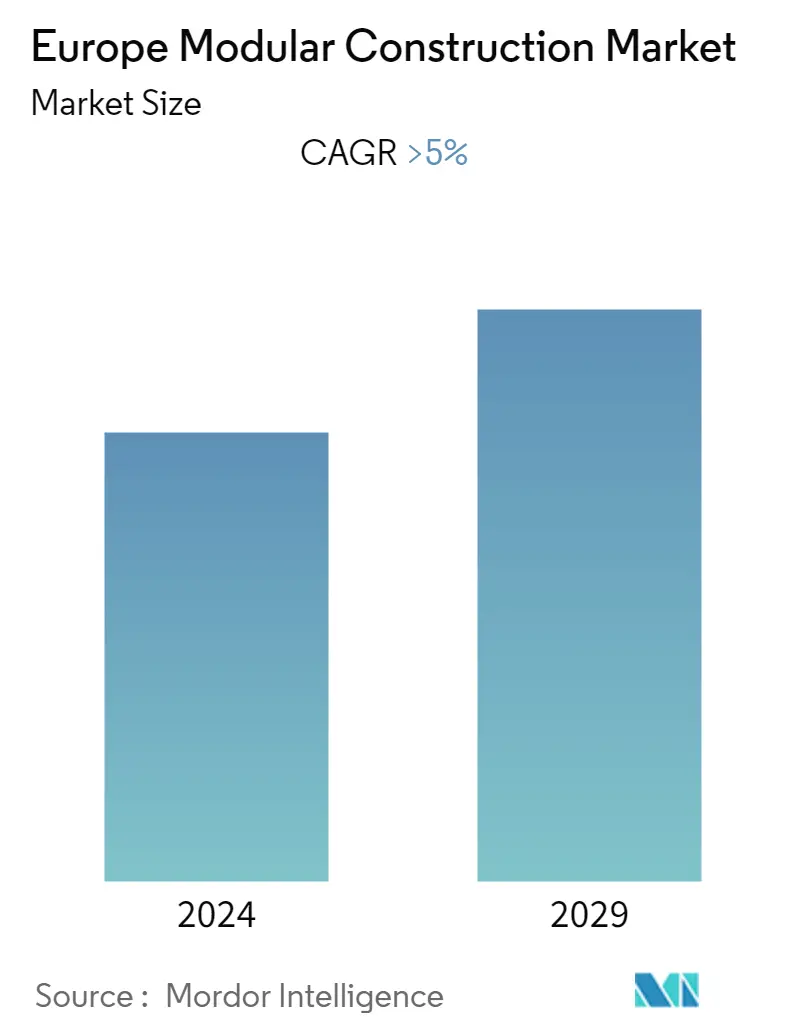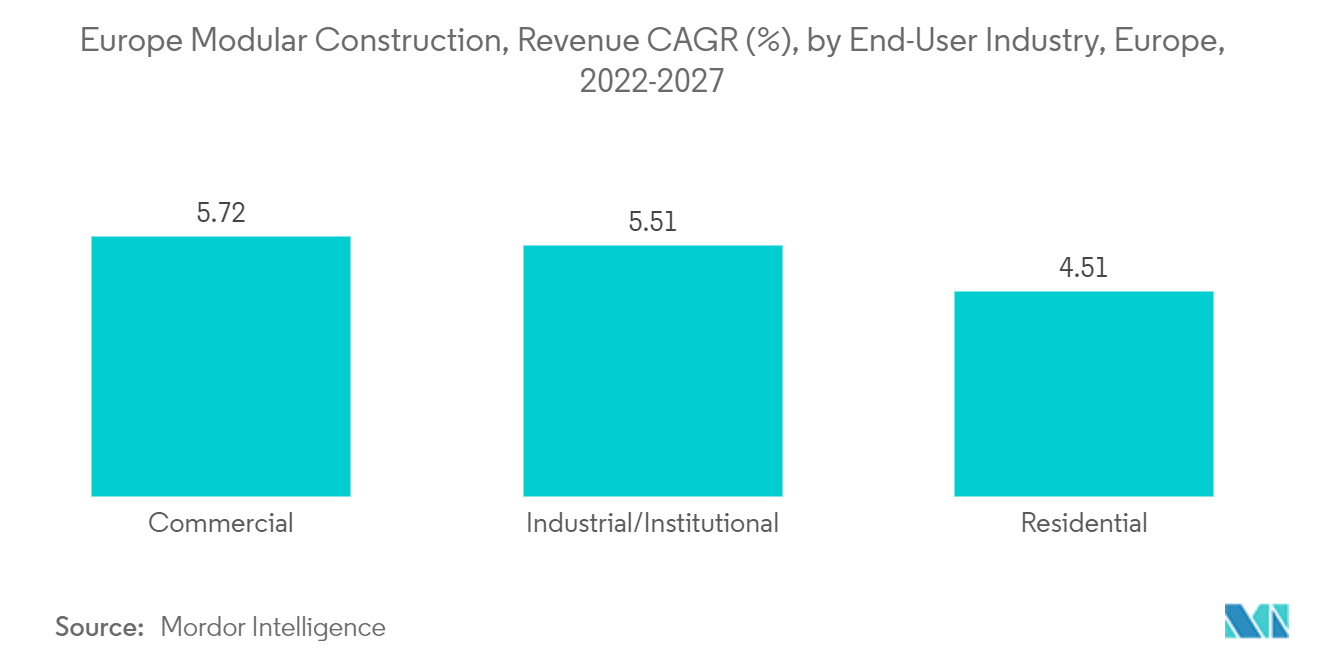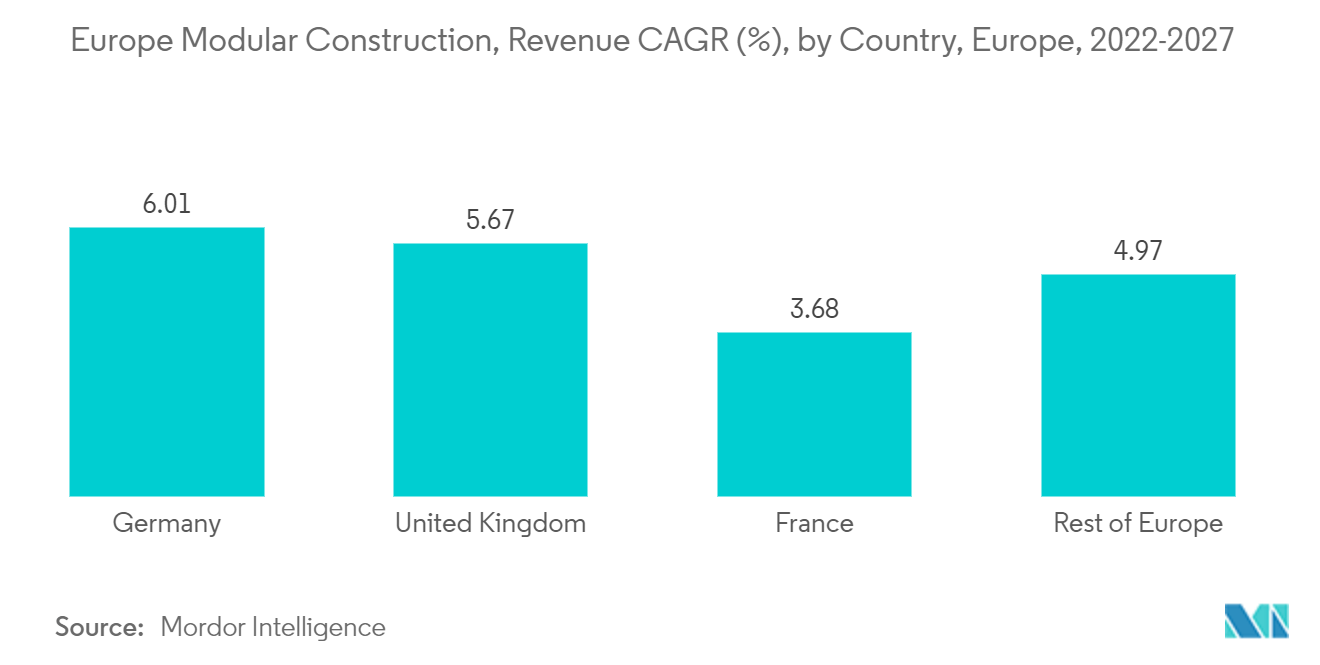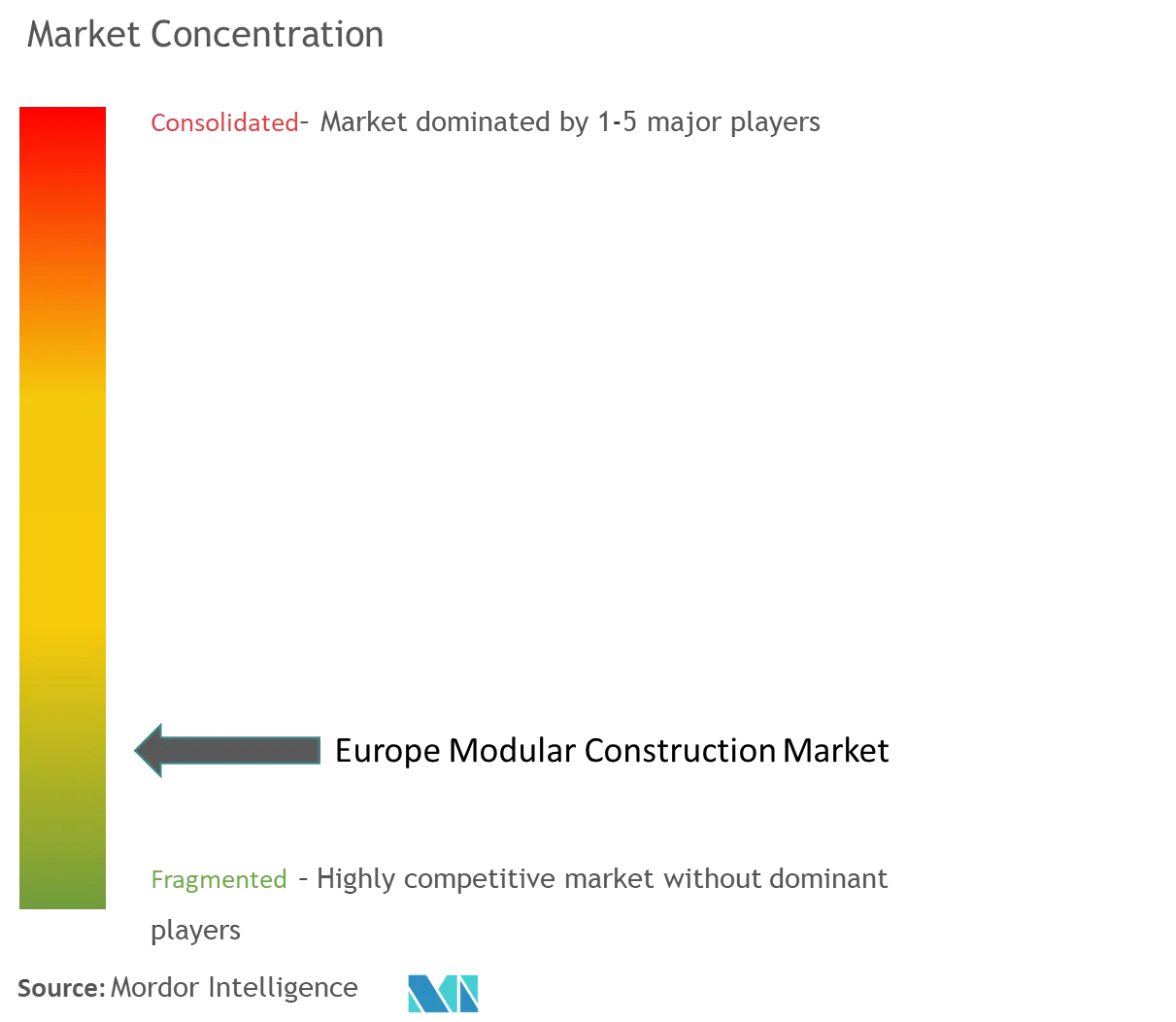European Modular Construction Market Size

| Study Period | 2021 - 2029 |
| Base Year For Estimation | 2023 |
| Forecast Data Period | 2024 - 2029 |
| Historical Data Period | 2021 - 2022 |
| CAGR | 5.00 % |
| Market Concentration | Low |
Major Players
*Disclaimer: Major Players sorted in no particular order |
European Modular Construction Market Analysis
The European modular construction market is estimated to reach USD 10332 million by the end of this year and is expected to grow at a CAGR of greater than 5% during the forecast period.
- The COVID-19 pandemic wreaked havoc on the economy, resulting in construction being halted and impacting labor-intensive sectors. The outbreak of the pandemic caused market turbulence and uncertainty across Europe. Furthermore, stock market volatility hurt manufacturer stock prices and trade volumes. As a result, new residential and non-residential development had declined significantly, reducing the demand for modular construction.
- The modular construction market is expected to grow because of the rising demand for permanent modular construction. This is because modular construction saves time and money compared to traditional construction.
- However, the higher initial funding required for setting up production on a huge scale and the high risk of project failure while shipping the finished construction model to the preferred site might pose a hindrance to the market's growth. Moreover, the impact of the recession could further weaken demand for modular construction across the European region.
- On the other hand, the growing need for higher-quality, eco-friendly homes all over the continent could be a chance for the modular construction market to grow.
- Germany is expected to lead the market for modular construction over the next few years because it has the biggest construction industry in Europe.
European Modular Construction Market Trends
This section covers the major market trends shaping the Europe Modular Construction Market according to our research experts:
Commercial Sector Expected to Dominate the Market
- Commercial buildings are constructed using the modular construction process in accordance with the International Building Code (IBC) or a version of a code modeled after the IBC and state regulations.
- The European modular market is very strong for commercial buildings. The most common examples are modular office buildings being used as extensions of existing buildings when companies need more space for their workers or as temporary offices while traditional buildings are being renovated.
- In Europe, according to the Europe Hotel Construction Pipeline Trend Report, at the close of the third quarter of 2021, Europe's hotel construction pipeline stood at 1,814 projects and 295,719 rooms and remained largely unchanged year-over-year.
- Moreover, the commercial sector did benefit from the COVID-19 scenario too. In Europe, various manufacturers found an increase in demand for storage space and distribution hubs as a result of the pandemic, with e-commerce replacing regular commerce and more groceries being delivered rather than bought in-store.
All the aforementioned factors are expected to drive the modular construction market in the commercial segment.

Germany Set to Dominate Growth in the European Region
- The German economy is the largest in Europe and the fifth-largest globally. According to the International Monetary Fund (IMF), GDP was estimated to rise to 2.8% in 2021, subject to the post-pandemic global economic recovery. The GDP is forecast to register a growth rate of 2.1% in 2022.
- Germany has the largest construction industry in Europe. The prefabricated building industry in Germany is booming, with high growth in the residential sector. Along with the general boom in residential construction in the country, the share of prefabricated housing solutions in residential construction is increasing, reaching more than 20%. Additionally, the high demand for turnkey solutions is increasing the demand for prefabricated houses, thus fueling the market's growth.
- The Federal Statistical Office says that in May 2021, 32,384 homes were allowed to be built in Germany. This is 8.7% more than in April 2021.In October 2021, the construction of 29,597 dwellings was permitted in Germany. The total number of building permits from January to October 2021 increased by 4.2% compared with the same period a year earlier.
- Moreover, millions of immigrants are projected to arrive in Germany in the coming few years and may require thousands of new dwellings. In 2021, the German government plans to build approximately 1.5 million new apartments.All such growth in the construction industry is likely to propel the country's market demand for modular buildings.
- Overall, based on the above factors, it is expected that the demand for modular constructions in Germany will continue and grow during the forecast period.

European Modular Construction Industry Overview
The European modular construction market is highly fragmented, with no player holding a significant share to influence the market. Some of the key players in European modular construction include Skanska, Modulaire Group, DFH Group, Daiwa House Modular Europe Ltd. (Jan Snel), and Elements Europe, among others.
European Modular Construction Market Leaders
-
Skanska
-
Modulaire Group
-
DFH Group
-
Daiwa House Modular Europe Ltd. (Jan Snel)
-
Elements Europe
*Disclaimer: Major Players sorted in no particular order

European Modular Construction Market News
- October 2022 : Japan's largest homebuilder, Daiwa House, announced their joint venture with Capital Bay to deliver modular construction across Europe. The JV will result in Capital Bay using modular construction units for its own projects and operator brands, but will also be offered to third-party customers in Europe.
- June 2022 : HS2 Ltd. (High Speed 2 - a planned high-speed railway line in the UK) announced that Laing O'Rourke Delivery Ltd will build HS2's new Interchange Station in Solihull, at the heart of Britain's new high-speed rail network. The contract, which is worth up to GBP 370 million, will see them work with HS2 Ltd in two stages to finalize the detailed design and then build the landmark station over the next few years.
European Modular Construction Market Report - Table of Contents
1. INTRODUCTION
- 1.1 Study Assumptions
- 1.2 Scope of the Study
2. RESEARCH METHODOLOGY
3. EXECUTIVE SUMMARY
4. MARKET DYNAMICS
-
4.1 Drivers
- 4.1.1 Growing Demand for Modular Construction in Commercial Segment
- 4.1.2 Rising Demand for Higher-quality, Eco-friendly Homes
-
4.2 Restraints
- 4.2.1 Requirement of Substantial Initial Financing owing to Size and Scale of Production
- 4.2.2 Impact of Recession
- 4.3 Industry Value Chain Analysis
-
4.4 Porter's Five Forces Analysis
- 4.4.1 Bargaining Power of Suppliers
- 4.4.2 Bargaining Power of Buyers
- 4.4.3 Threat of New Entrants
- 4.4.4 Threat of Substitute Products and Services
- 4.4.5 Degree of Competition
5. MARKET SEGMENTATION (Market Size in Value)
-
5.1 Type
- 5.1.1 Permanent
- 5.1.2 Relocatable
-
5.2 Material
- 5.2.1 Steel
- 5.2.2 Concrete
- 5.2.3 Wood
- 5.2.4 Plastic
-
5.3 End-user Industry
- 5.3.1 Commercial
- 5.3.2 Industrial/Institutional
- 5.3.3 Residential
-
5.4 Geography
- 5.4.1 Germany
- 5.4.2 United Kingdom
- 5.4.3 France
- 5.4.4 Italy
- 5.4.5 Rest of Europe
6. COMPETITIVE LANDSCAPE
- 6.1 Mergers and Acquisitions, Joint Ventures, Collaborations, and Agreements
- 6.2 Market Share (%)**/Ranking Analysis
- 6.3 Strategies Adopted by Leading Players
-
6.4 Company Profiles
- 6.4.1 Berkeley Group
- 6.4.2 Bouygues Batiment International
- 6.4.3 Daiwa House Modular Europe Ltd. (Jan Snel)
- 6.4.4 DFH Haus GmbH
- 6.4.5 Elements Europe
- 6.4.6 Karmod Prefabricated Technologies
- 6.4.7 Laing O'Rourke Corpt Ltd.
- 6.4.8 Modulaire Group
- 6.4.9 Modubuild
- 6.4.10 Moelven Industrier ASA
- 6.4.11 Skanska AB
- *List Not Exhaustive
7. MARKET OPPORTUNITIES AND FUTURE TRENDS
- 7.1 Healthcare Sector Embracing Modular Construction
European Modular Construction Industry Segmentation
Modular construction is a construction technique that involves the prefabrication of 2D panels or 3D volumetric structures in off-site factories and transportation to construction sites for assembly. This process has the potential to be superior to traditional construction in terms of both time and cost. The Europe modular construction market is segmented by type, material, end-user, and by geography. By type, the market is segmented into permanent and relocatable. By material, the market is segmented into steel, concrete, wood, and plastic. By end-user the market is segmented into commercial, industrial/institutional, and residential. The report covers market sizes and forecasts for four major countries across the region. For each segment, the market sizing and forecast have been done on the basis of revenue (in USD million).
| Type | Permanent |
| Relocatable | |
| Material | Steel |
| Concrete | |
| Wood | |
| Plastic | |
| End-user Industry | Commercial |
| Industrial/Institutional | |
| Residential | |
| Geography | Germany |
| United Kingdom | |
| France | |
| Italy | |
| Rest of Europe |
European Modular Construction Market Research FAQs
What is the current Europe Modular Construction Market size?
The Europe Modular Construction Market is projected to register a CAGR of greater than 5% during the forecast period (2024-2029)
Who are the key players in Europe Modular Construction Market?
Skanska, Modulaire Group, DFH Group, Daiwa House Modular Europe Ltd. (Jan Snel) and Elements Europe are the major companies operating in the Europe Modular Construction Market.
What years does this Europe Modular Construction Market cover?
The report covers the Europe Modular Construction Market historical market size for years: 2021, 2022 and 2023. The report also forecasts the Europe Modular Construction Market size for years: 2024, 2025, 2026, 2027, 2028 and 2029.
What are the driving factors behind the growth of the Europe Modular Construction Market?
The driving factors behind the growth of the Europe Modular Construction Market are a) Increased demand for affordable housing, commercial buildings, and infrastructure projects b) Recognition of modular construction as a sustainable construction method c) Technological advancements such as 3D printing, advanced robotics, Building Information Modeling (BIM), and digitalization
European Modular Construction Industry Report
The Europe modular construction market is experiencing significant growth, driven by various factors across different segments such as type, material, and application. Notable growth is seen in both permanent and relocatable modular constructions, with key materials including steel, concrete, and wood, chosen for their structural benefits and sustainability. The versatility and efficiency of modular construction are evident across commercial, healthcare, education, hospitality, and residential sectors. European modular construction companies particularly favor this method for its ability to expedite construction processes, reduce costs, and minimize environmental impact through energy efficiency and reduced waste. The market's expansion is further propelled by the increasing demand for infrastructure development, including roads, rails, and bridges, and the need for quick assembly in response to natural disasters or temporary infrastructure needs. Challenges such as economic downturns and geopolitical tensions can impact investment and material supply chains. For a comprehensive understanding, the Modular Construction Report Europe provides an in-depth analysis, including market share, size, revenue growth rate, and a forecast outlook. Get a sample of this industry analysis as a free report PDF download from Mordor Intelligence™ Industry Reports.



